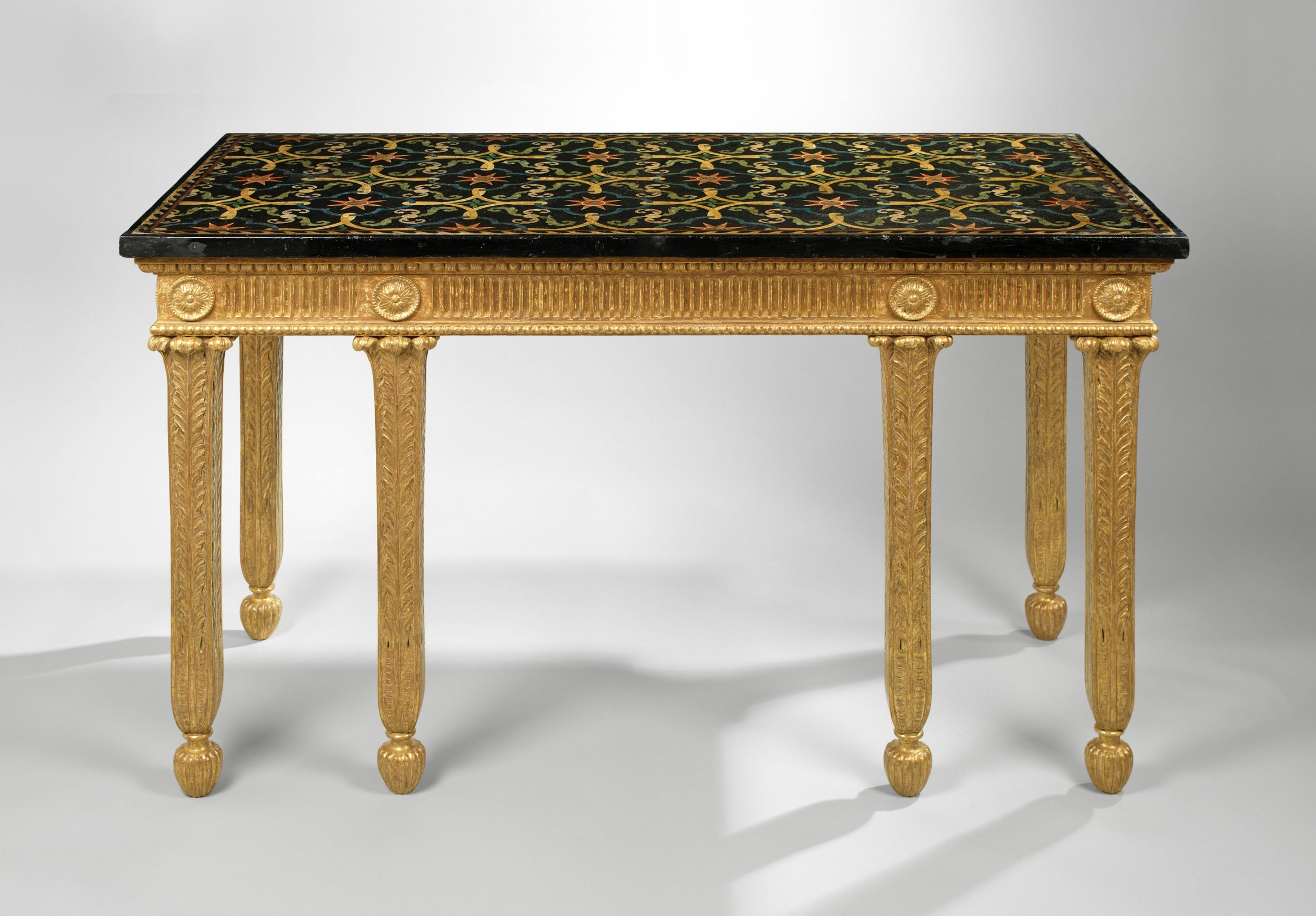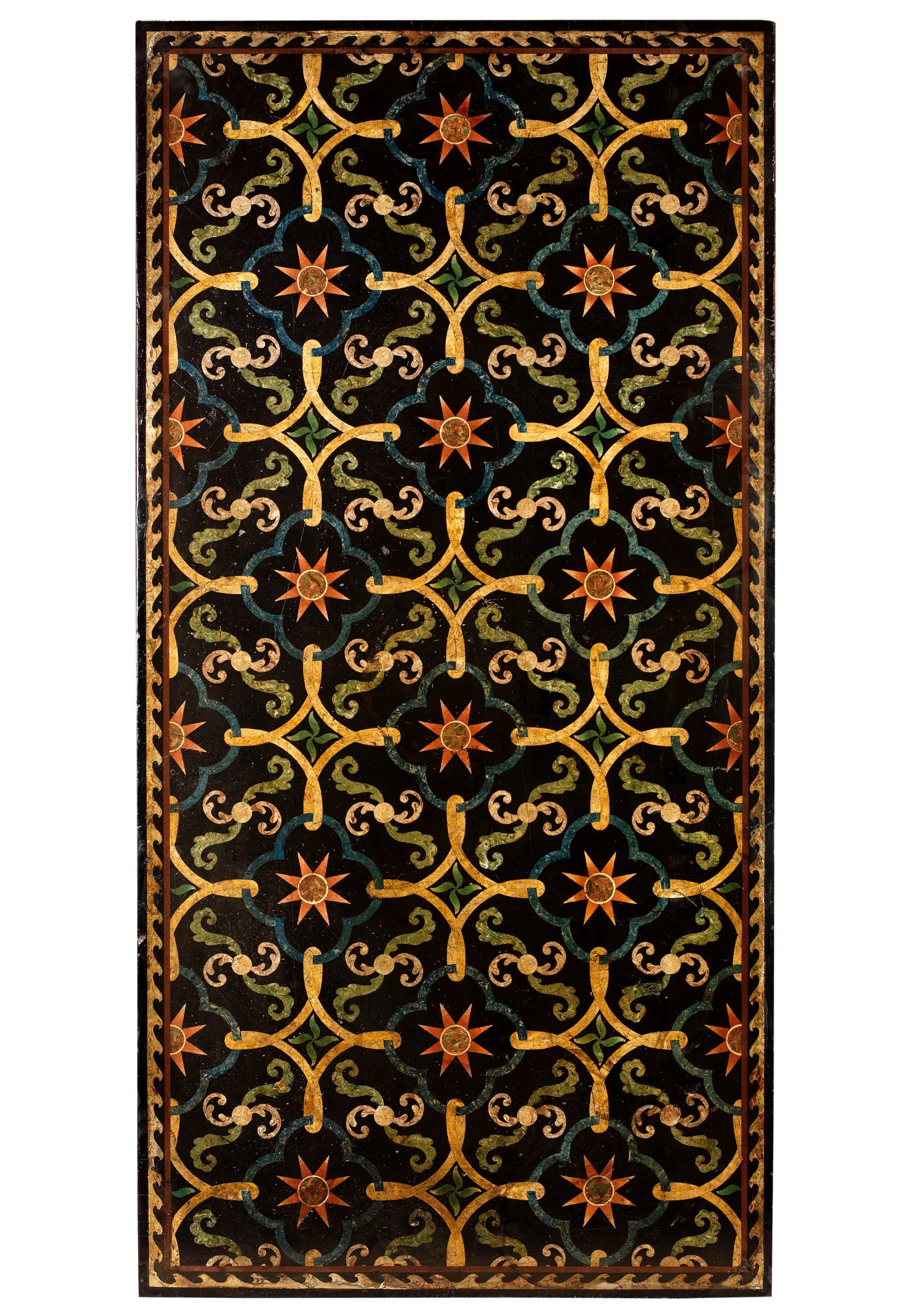

1770


The interlocking and foliate-patterned scagliola top with Vitruvian scroll border above egg-and-dart molding and a fluted frieze, foliate medallions above each of six foliate-carved legs, on reeded feet.
Possibly made for the Cinamon drawing room at Harewood House
Charles Adams Lloyd-Baker
And by descent Lloyd-Baker family, Granville Edwin Lloyd-Baker family of Hardwicke Court, Glos married Catherine Lascelles, daughter of Hon Arthur Lascelles ( son of 2nd Earl of Harewood)
This extraordinary table may be confidently attributed to London's pre-eminent cabinet-maker Thomas Chippendale based on its remarkably close comparison to one supplied for Edwin Lascelles at Harewood House, Yorkshire, one of his most celebrated commissions . The Harewood table features the same unusual legs and separately-turned reeded feet, although there are only four legs in total. The frame patterns correspond although the medallions on the Harewood example regularly intersperse the fluting rather than simply heading the legs. Christopher Gilbert in his The Life and Works of Thomas Chippendale (p. 204) notes its similarity in design to models published by Matthias Lock in his Book of Pier Frames, etc., of 1769, notably pl. 2 (see M. Heckscher, 'Lock and Copland: A catalogue of the Engraved ornament', Furniture History, 1979, pl.65A). The table, now with a later marble top, is currently situated in the Gallery on the State Floor of Harewood. While a significant amount of Chippendale and Haig papers are preserved among the Harewood manuscripts, these records do not begin until December 1772, at which time Chippendale had already been employed for as many as four years and £3,000 had already been spent (A. Stephenson, Chippendale Furniture at Harewood', Furniture History, 1968, pp. 62-69). This table, thought to have been supplied in circa 1769, pre-dates the existing documentation. It is instructive to note the existence of another gilt-framed table supporting a patterned scagliola top at Harewood (see C. Gilbert, op.cit, vol. II, p. 272, fig. 497
The art of scagliola inlay (from the Italian 'scaglia' or chips) became fashionable in England and Ireland in the late 18th century. It was a technique perfected in various centers in Italy including Florence and Carpi, utilizing selenite (a form of gypsum), glue and pigments to imitate marble and hardstones, and was perfectly suited to the taste for the 'antique'. The architect James Adam was much impressed when visiting Florence in 1760, admiring the work of specialists such as Enrico Hugford and Lamberto Cristiano Gori. The marble-mosaiced slabs, recalling 'Roman pavement', harmonized beautifully with Adam's integrated interiors. The celebrated Italian 'Inlayer in Marble and Stucco-work' Domenico Bartoli, together with his partner John (Johan) Augustus Richter, worked almost exclusively for Robert Adam from 1767 to 1777. Related tops feature on the pair of 'mosaic tables' supplied to Coventry House, London in 1768 which were executed to Adam's design; the table frames, also designed by Adam, were carved by Sefferin Alken (E. Harris, The Genius of Robert Adam, London, 2001, pp. 57-58, pl. 83-84). Similarly, the Eating Room pier-tables at Osterley Park, executed after Adam's 'sideboard-table' design of the same year, support related 'Antique marble Slabs' (op. cit., p.162, figs. 231 and 233). Chippendale and Adam worked together on many celebrated commissions. At Harewood, Adam was the architect but the furniture commission went exclusively to Chippendale. Eileen Harris states that none of the furniture is integrated with Adams interior decoration (ibid, p. 137), however it is interesting to compare the patterned scagliola top here in its patterning and color selection to the ceiling design for the second drawing-room (now the Cinnamon Drawing Room) executed by Adam in 1767 (p. 144, fig. 208). Other commissions shared by the two artisans include Newby (as previously noted), Nostell Priory (where Bartoli and Richter supplied tops for Adam-designed Salon tables; Gilbert, p. 173) as well as Osterley, Kenwood and, of course, the Dundas houses including the celebrated suite of giltwood seat furniture.
| Dimensions | CM | Inches |
|---|---|---|
| Width: | 142 | 56 |
| Depth: | 71 | 28 |
| Height: | 87 | 34 |